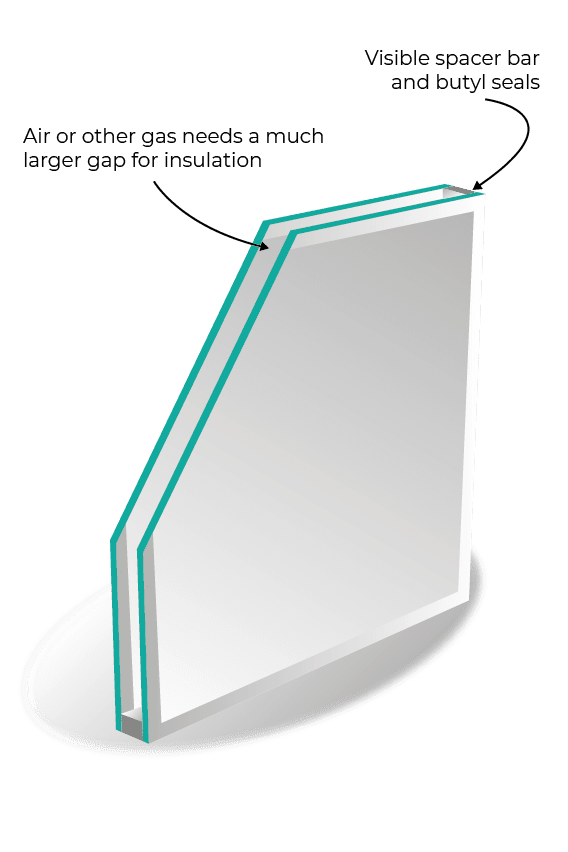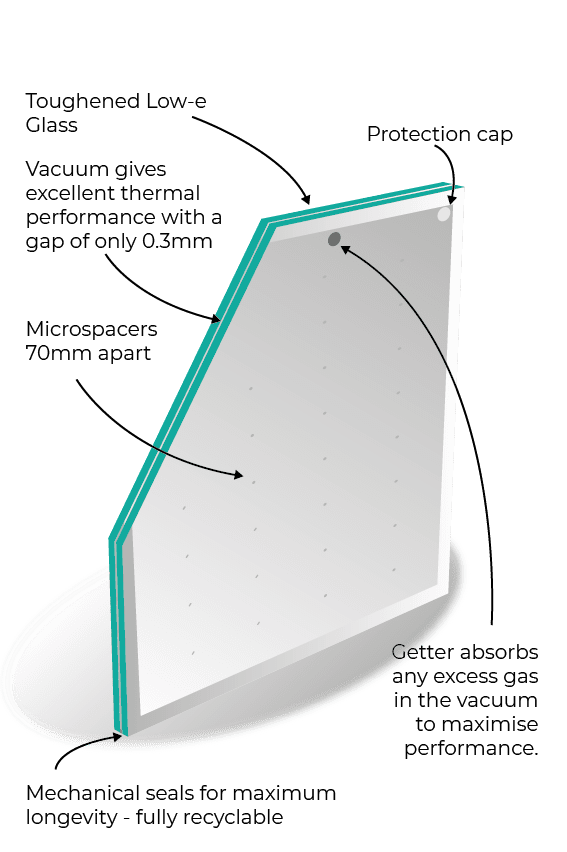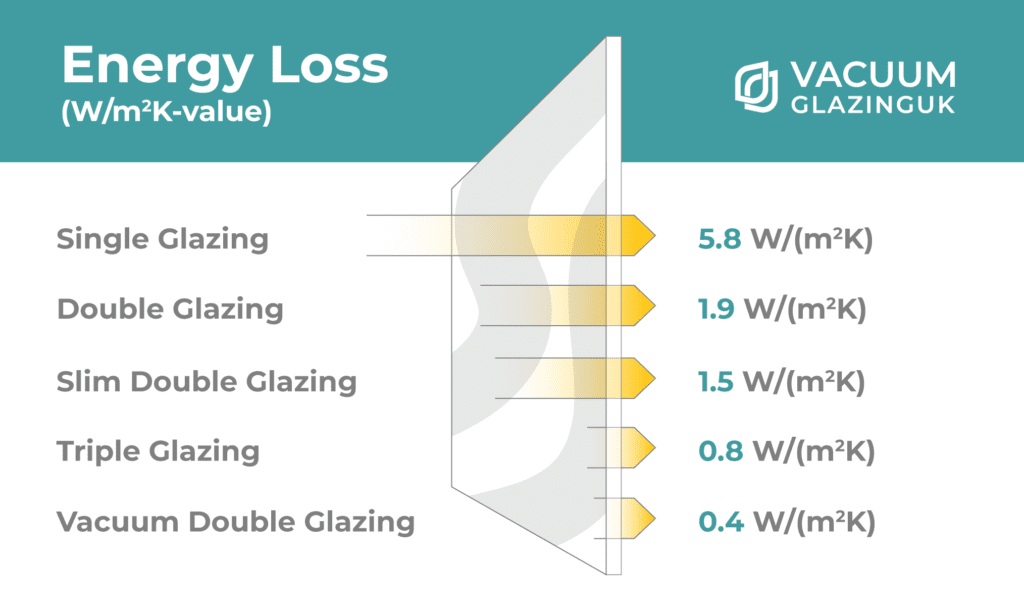Vacuum double glazing explained
Vacuum double glazing is a type of glass that has two panes separated by a vacuum cavity. It is also known as vacuum-insulated glazing or insulated glazing, and it’s primarily used in houses where owners want better insulation combined with improving the visual aspect of their homes. Vacuum double glazing helps reduce heat loss through windows because the vacuum between the panes acts as a highly efficient insulator.
Unfortunately, there are lots of myths and misinformation about vacuum double glazing that can make it seem like an unsuitable investment. To help you understand whether this type of glass is right for your property, we’ve compiled everything you need to know about vacuum double glazing, including the pros and cons, costs, insulation benefits, and installation tips.
Unrivalled Energy Efficiency
Centre-pane U-values of 0.4 Passive house levels of performance.
Exceptionally Thin
Ultra-slim 8.3mm units have no double reflection and suit all property types.
Safe and Long Lasting
4mm toughened glass and a 15-year warranty, as standard.
How Standard Double Glazing Works
Standard double glazing is made of 2 panes of glass separated by a cavity filled with an inert or noble gas – usually argon. Noble or inert gas is denser than air, so heat and sound cannot cross it very easily. This reduced thermal conductivity gives the windows insulating properties. The insulating properties can be improved by using different types of glass with improved thermal properties.
Standard Double Glazing

Vacuum Glazing

The Problems with Standard Double-Glazed Windows
Whilst double-glazed windows are a vast improvement on the old single-glazed windows, they are not without their problems.
Firstly, the gap between the two panes of glass is anything from 14mm to 25mm. This means that the ugly inner frame is clearly visible, it’s not very nice looking and spoils the look of the windows.
This gap is especially problematic in heritage projects – the renovation of Listed buildings and those in conservation areas. In these window installations, it’s a requirement that the replacement units look as much like the original windows as possible. In older buildings, this means single glazing. Obviously, any homeowner is going to want to improve the efficiency and comfort of their home. Single glazing may be prettier, but it allows most of the heat out of the rooms resulting in uncomfortable living conditions and higher heating bills.
There’s also the double image effect that two widely separated panes of glass give. This is unacceptable to planning officers when dealing with heritage projects.
Ultra slim double glazing was developed to help combat these problems. While these units somewhat satisfy the need for the appearance of single glazing (not entirely), they tend to fail around the seals because the upstands and seals are too slim. Some ultra-slim double-glazing manufacturers have even been taken to trading standards by the Glass and Glazing Federation (GGF https://www.ggf.org.uk/) because of the quality issues that are inherent in ultra-slim double-glazing.
How Vacuum Double Glazing Works
In vacuum double glazing, the cavity has all the air removed. Because heat and sound cannot cross a vacuum, this makes for a very efficient window with great insulation properties.
Because a vacuum has the same properties no matter if it’s .1mm or the vastness of space, the cavity between the two panes can be incredibly small and still have the same heat and sound-insulating properties.

What are the Benefits of Vacuum Double Glazing?
Reduce Heat Loss
- Warmer Rooms
- Lower Energy Bills
- Better for the Environment
Reliability
- Extended service life
- 15 year guarantee
- No history of failure
Better Looking
- Allow more light into rooms
- No ugly sight lines
- Ultra slim profile
Reduce Noise
- Quieter indoors
- Less outside noise
- More privacy & focus
Seamless Integration
- Seamless integration into existing frames
- Minimal disruption to building fabric
- Cost-effective installation in new or retrofit projects
Wide Availability
- Widely available in the UK
- Quick and reliable lead times
- Versatile and customizable shapes and sizes
Vacuum double glazing offers a number of benefits compared to standard double-glazed windows. These include better thermal insulation and sound reduction, as well as improved looks and more chance of compliancy in heritage projects.
Vacuum double glazing helps reduce heat loss through windows because the vacuum between the panes acts as a super-efficient insulator. Because of the vacuum cavity, the glass has a lower U-value even than triple glazing, which means it insulates better.
Vacuum insulated glazing also reduces the amount of noise from outside, as sound cannot cross a vacuum.
- Enjoy a quieter and more peaceful indoor environment
- Reduce outside noise pollution for a better quality of life
- Enhance privacy and concentration by minimising noise disturbances

Is vacuum Double Glazing Worth the Cost?
In most cases, vacuum double glazing is a sound investment. It is often used in tandem with other forms of insulation and can help to reduce energy bills for the homeowner. In the current energy crisis (October 2022) vacuum glazing can help homeowners keep their bills down, especially when other improvements are made to insulate the property.
Vacuum double glazing is more expensive than standard double glazing, but most people feel that it’s worth it for the aesthetic improvements alone. It’s also worth considering that the metallic perimeter seal is much more resilient than a typical butyl seal on a double or triple glazed unit. The standard guarantee for a vacuum insulated unit is 15-years, compared to 10-years on other insulated unit, but the expectation is that the lifespan will be far longer. This makes a significant difference when you are assessing total life costs.
Conclusion
The vacuum-insulated glass used in vacuum double glazing is a great way to improve the energy efficiency of a home. It offers a number of benefits including reduced heat loss and improved sound reduction, and it can also help to improve the looks of a home. While vacuum double glazing is more expensive than standard double glazing, it also provides greater value thanks to its superior insulation properties and longer expected lifespan. Anyone can install vacuum double glazing, and it makes a great investment for any homeowner.